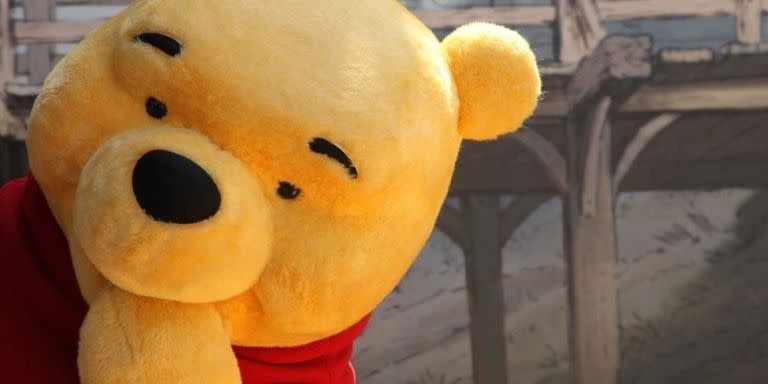11 Things You Didn't Know About Winnie the Pooh

- Oops!Something went wrong.Please try again later.
Everyone's favorite honey-loving bear in a red crop top has been around since 1926, when A. A. Milne released his first collection of short stories. But the inspiration behind what's now one of the most popular storybook characters of all time is a complicated topic. Here's everything you don't know about Winnie the Pooh:
1. A real-life bear started it all.
In her new children's book Finding Winnie, author Lindsay Mattick reveals that back in 1914, a Canadian veterinarian named Lt. Harry Colebourn bought a bear for $20 while serving in WWI. He named his new pet Winnie, after his native Winnipeg, and the cub ended up serving as a mascot for the regiment while he was stationed in England. However, when the soldier left for France, he left Winnie behind where it was safer at the London Zoo.

2. But unlike in the books, Winnie was a girl.
Color us surprised! But it's true.
3. The storybook character was inspired by a stuffed bear A. A. Milne's son owned.
The plush toy was named (you guessed it) Winnie the Pooh, in honor of the Canadian bear his son saw at the London Zoo. The rest of the characters were also in his toy collection — with the exception of Owl, Rabbit, and Gopher, who were added later for variety.

4. And Christopher Robin was the name of Milne's son.
In this case, art seems to imitate life. Unfortunately as an adult, the real-life Christopher Robin resented his father for using his name in his stories, which he wrote about in his memoir: "It seemed to me almost that my father had got where he was by climbing on my infant shoulders, that he had filched from me my good name and left me with nothing but empty fame."
5. The "Pooh" part of the Winnie's name actually came from a swan.
But the exact origin is a hard to pinpoint: Some sources say that the Milne family met a swan named Pooh on vacation, and Milne also refers to a swan named "Pooh" in his poem called "The Mirror." "Christopher Robin, who feeds this swan in the mornings, has given him the name of 'Pooh,'" Milne wrote. "This is a very fine name for a swan, because, if you call him and he doesn't come (which is a thing swans are good at), then you can pretend that you were just saying 'Pooh!' to show him how little you wanted him."
Mattick also told The Huffington Post that "pooh!" was the sound Christopher Robin would make to blow away feathers a friends' pet swan (yep, another swan) would shed. But regardless, eventually "Winnie" paired with "the Pooh," and the rest is history.
6. The illustrations of the character were inspired by yet another (!) bear.
Keeping up? Illustrator E. H. Shepard's sketches were based off of his son's stuffed bear, Growler — which explains why Winnie isn't a black bear.

7. Most of the locations from the imaginary world were based on a forest near Milne's country home.
The Ashdown Forest in Sussex, England, to be specific. Milne bought a house there in 1925 and it served as the inspiration behind The Hundred Acre Wood (the real version is called the Five Hundred Acre Wood!), Roo's Sandpit, and more.
8. The original plus toys can be seen at the New York Public Library.
Well, except Roo, who Christopher Robin lost in his thirties.

9. The adventures of this popular bear have been translated into 50 different languages.
Including Yiddish, Afrikaans, and Esperanto.
10. And the Latin translation is the only Latin book to ever earn a spot on The New York Times best-seller list.
The 1960 release stayed on the charts for 20 weeks and sold 125,000 copies. People just love that bear – no matter the language!
11. Winnie the Pooh is now one of Disney's most popular characters of all time.
Walt Disney purchased the motion picture rights in 1961, which resulted in a brand that still thrives for the company today — he even earned a star on the Walk of Fame!

You Might Also Like

